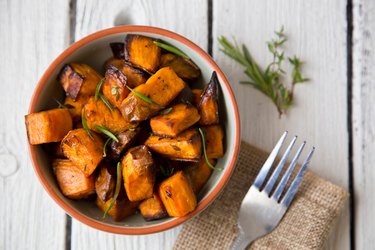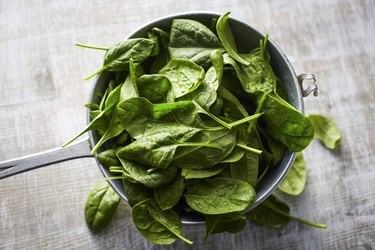Vitamin A plays a critical role in body functions like reproductive and skin health, immunity and vision, per the Harvard T.H. Chan School of Public Health.
There are two primary forms of vitamin A in the diet:
Video of the Day
- Retinol or preformed vitamin A: Occurs in animal foods, such as liver, eggs and beef, among others.
- Beta-carotene or provitamin A: Occurs in plant foods, such as sweet potatoes and pumpkin, and gets converted to retinol in the body.
How Much Beta-Carotene Do You Need Per Day?
There's no recommended dietary allowance (RDA) for beta-carotene specifically, but there is one for vitamin A — and it differs for people assigned male at birth (AMAB) and people assigned female at birth (AFAB).
The RDA for vitamin A is measured in retinol activity equivalents (RAE). These units account for the fact that not all active vitamin A is derived directly from retinol — it can also come from vitamin A precursors like beta-carotene. For example, 1 microgram (mcg) RAE is equivalent to 1 mcg of retinol or 12 mcg of dietary beta-carotene.
The RDA for people AMAB is 900 mcg RAE while the RDA for people AFAB is 700 mcg RAE, per the National Institutes of Health (NIH). Pregnant and lactating people require higher amounts of vitamin A, at 770 and 1,300 mcg RAE, respectively.
Video of the Day
There aren't any beta-carotene side effects, but eating high amounts over a long period of time can lead to carotenemia — a condition that causes your skin to turn yellow-orange (but this isn't harmful), per a January 2022 report in StatPearls.
The Daily Value (DV) percentages listed below represent the proportion of RAE that each food provides based on an RDA of 900 mcg RAE for adults. Here are the highest beta-carotene foods.
Tip
Eat whole-food sources of beta-carotene for health benefits like vision support and chronic disease protection. Beta-carotene supplements have been linked to an increased risk of lung cancer in people who smoke or have been exposed to asbestos, per the Mayo Clinic.
1. Sweet Potato: 214% Daily Value (DV)

Sweet potatoes are one of the richest sources of beta-carotene. A nourishing source of complex carbs, 1 cup of baked sweet potato offers an impressive 1,922 mcg RAE or 214 percent of the DV for vitamin A. Enjoy your sweet potato with the skin on for an extra hit of gut-friendly fiber.
Tip
Beta-carotene is fat-soluble, so you’ll improve your body’s absorption of the nutrient if you pair it with a source of healthy fat. Go ahead and drizzle olive oil, tahini, nut butter or another fat-rich food on top of your sweet potatoes to maximize the bioavailability of beta-carotene.
2. Canned Pumpkin: 212% DV
As if we needed another reason to love pumpkin season. Just 1 cup of canned pumpkin provides 1,906 mcg RAE or 212 percent of the DV for vitamin A.
Fun fact: Foods that provide more than 20 percent of the DV for a certain nutrient are considered excellent sources of that nutrient, so it's safe to say pumpkin is a must for those looking to bump up the amount of beta-carotene they eat.
3. Carrots: 148% DV
Carrots have a good rap for helping your eyesight. That's because vitamin A is needed for the cells of the retina to function optimally, per Oregon State University.
With 1,329 mcg RAE or 148 percent of the DV for beta-carotene in a 1 cup of cooked carrots, the root vegetable is a stellar source of provitamin A, which supports eye health along with other carotenoids like lutein and zeaxanthin.
4. Butternut Squash: 127% DV
Butternut squash is a starchy vegetable that tops the list for its beta-carotene content. One cup of cooked butternut squash delivers 1,144 mcg RAE or 127 percent of the DV for vitamin A.
Try the veggie in these butternut squash recipes that are high in protein.
5. Spinach: 105% DV

We've said it before and we'll say it again: Eat your greens. They're a great source of vitamin K, but veggies like spinach are also some of the top beta-carotene foods. One cup of cooked spinach provides 943 mcg RAE or 105 percent of the DV for vitamin A.
Spinach also serves up non-heme iron, blood pressure-stabilizing potassium and gut-healthy fiber.
6. Collard Greens: 80% DV
If you ask us, collard greens are totally underrated. The hearty greens, which provide 722 mcg RAE or 80 percent of the DV for vitamin A per cup cooked, are a welcome addition to cozy soups and stews. Check out these antioxidant-packed meals with collard greens.
Remember, beta-carotene is fat-soluble, so sautéeing your leafy greens in olive or avocado oil can help improve your body's absorption of the nutrient.
7. Cantaloupe: 33% DV
We all ought to be putting more orange on our plate. Just 1 cup of cantaloupe brings 299 mcg RAE or 33 percent of the DV for vitamin A to the table. Research suggests that eating four or more daily servings of produce with beta-carotene is linked to a lower risk of chronic conditions like heart disease or cancer, according to Mount Sinai.
Opt for cantaloupe paired with protein-rich cottage cheese at breakfast and incorporate other beta-carotene-rich eats like sweet potatoes and bell peppers at dinner and snacks throughout the day.
8. Red Bell Pepper: 26% DV

The perfect vehicle for a heart-healthy dip, red bell peppers are high in beta-carotene: 1 cup of raw, chopped red bell peppers covers 234 mcg RAE or 26 percent of the DV for vitamin A.
Bell peppers are also rich in immune-supportive vitamin C, with the same 1-cup serving providing over 200 percent of the DV for vitamin C.
9. Kale: 21% DV
One cup of cooked, chopped kale provides 190 mcg RAE or 21 percent of the DV for vitamin A. The leafy green is also packed with fiber that helps support digestion, as well as calcium.
Don't miss these creative and tasty ways to eat kale when you're officially over eating salads. Other green veggies like broccoli have beta-carotene but not in as high amounts.
10. Mango: 10% DV
The tropical fruit is loaded with nourishing nutrients that aid in digestion, immunity and skin health.
You'll get 89 mcg RAE or 10 percent of the DV for beta-carotene in 1 cup of mango, plus fiber and vitamin C. After all, vitamin C is required for the production of collagen in the body and beta-carotene, and acts as an antioxidant, helping to fight free radical damage in the body.
Related Reading
- Harvard T.H. Chan School of Public Health: “Vitamin A”
- National Institutes of Health: “Vitamin A Fact Sheet for Health Professionals”
- Oregon State University: “Vitamin A”
- Mayo Clinic: “Beta Carotene (Oral Route)”
- Mount Sinai: “Beta-carotene”
- Mount Sinai: “Vitamin A (Retinol)”
- My Food Data: "Top 10 Foods High in Vitamin A"
- My Food Data: "Canned Pumpkin"
- My Food Data: "Cooked Carrots"
- My Food Data: "Cooked Butternut Squash"
- My Food Data: "Baked Sweet Potatoes"
- My Food Data: "Cooked Spinach"
- My Food Data: "Cooked Collards"
- My Food Data: "Cantaloupe Melons"
- My Food Data: "Sweet Red Bell Peppers"
- My Food Data: "Cooked Kale"
- My Food Data: "Mangos"